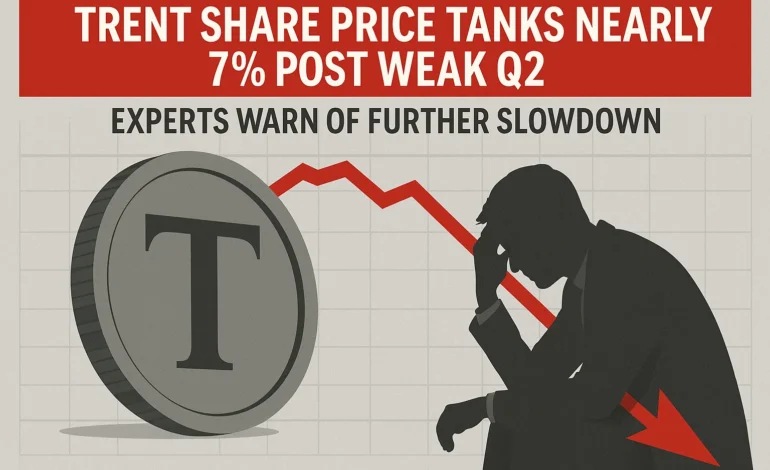Trent Share Price Tanks Nearly 7% Post Weak Q2 | Experts Warn of Further Slowdown

Table of Contents
Trent share price has become a cautionary tale for retail investors tracking India’s fashion sector. On November 10, 2025, shares plummeted nearly 6.50% to close at ₹4,627.30, marking another painful chapter in the stock’s declining trajectory. The Tata Group-owned retailer reported Q2FY26 results that exposed deepening growth challenges despite operational margin improvements, prompting multiple brokerages to slash price targets and signal growing investor concerns about the company’s near-term prospects.
The trent share price collapse reflects a broader investor disappointment with the company’s revenue growth deceleration. While profit metrics showed resilience with an 11% year-on-year net profit increase to ₹376.86 crore, revenue growth slowed to just 17% year-on-year, falling significantly short of management’s guided 20-25% range.
This marked Trent’s weakest quarterly revenue growth in multiple quarters, a red flag for a retailer that built its reputation on double-digit growth acceleration. The stock has already declined 30.94% in the past twelve months and 38.93% year-to-date, reflecting persistent skepticism about the company’s ability to recover momentum.
The Revenue Growth Reality Check

Trent’s Q2FY26 revenue climbed to ₹4,817.68 crore from ₹4,156.67 crore year-ago, representing solid absolute growth but a troubling slowdown relative to recent quarters. Morgan Stanley noted that consolidated revenue and EBITDA rose 16% and 27% year-on-year respectively, but this growth masks underlying stress in the core fashion segment, where like-for-like sales remained stuck in low single-digits. The company’s sequential revenue actually declined 1.4% from ₹4,883 crore in the June quarter, signaling demand weakness despite festive season expectations.
The culprits behind this slowdown are multifaceted. Unseasonal rains dampened consumer discretionary spending during the quarter, while muted sentiment in branded apparel segment persisted despite initial GST-cut tailwinds. More critically, Trent’s aggressive expansion into tier-2 and tier-3 markets—adding 40 Zudio stores and 13 Westside outlets in Q2—is creating what analysts term “store-level sales cannibalization.”
Revenue per square foot fell 17% year-on-year as newer stores diluted overall productivity metrics. Management acknowledged that customer sentiment remained “relatively muted” during Q2, an admission that contradicts earlier optimism about festival season recovery.
Broker Downgrades Signal Investor Caution
The reaction from investment banks has been decidedly mixed but increasingly bearish. Jefferies maintained its “Hold” rating but slashed the trent share price target to ₹5,000 from ₹6,000, citing “continued growth deceleration in the company’s key fashion segment”. This 16.7% target reduction signals Jefferies’ view that near-term headwinds will persist longer than previously estimated.
Morgan Stanley, meanwhile, struck a more constructive tone by maintaining an “Overweight” call with a target price of ₹5,456, implying an 18% upside. The brokerage credited Trent’s “resilient margins” and efficient cost management despite demand challenges, highlighting that standalone EBITDA margins held steady at 17.2%. However, even this optimism comes with caveats: Morgan Stanley’s forecast for FY27 revenue growth of 8-10% sits well below prior 12-15% estimates, indicating skepticism about a near-term recovery.
Motilal Oswal cut its target price to ₹6,000 from a prior higher level but maintained a “Buy” rating, emphasizing that margin improvements through cost control offset topline weakness. Conversely, Citi took a far more pessimistic stance, downgrading to “Sell” and slashing its target from ₹7,150 to ₹4,350—a 39% reduction that reflects fears of further growth moderation driven by weak consumption trends and rising competitive pressure.
Consensus analyst sentiment remains divided: of 27 analysts tracked, 16 maintain “Buy” ratings, 5 recommend “Hold,” and 6 suggest “Sell,” with an average 12-month price target of ₹5,454.64 implying 25.9% upside from current levels. This wide dispersion underscores analyst uncertainty about whether Trent’s operational strengths can overcome macro headwinds.
The Like-For-Like Sales Problem Deepens
A critical metric—fashion like-for-like growth—reveals the true severity of Trent’s challenge. Trent’s own management acknowledged that LFL growth in fashion categories remained “low single digit” during Q2, a dramatic deceleration from the 10%+ LFL growth the company achieved in stronger periods. This bifurcation matters: while emerging categories like beauty, personal care, and footwear contributed over 21% of revenue, the core fashion business—Trent’s historical profit engine—is losing momentum precisely when expansion costs are accelerating.
The company’s aggressive store-opening pace (200-220 stores annually) is outpacing same-store sales improvements, creating a mathematical problem. Each new store requires 12-18 months to reach maturity, meaning near-term revenue per square foot will remain pressured unless fashion demand rebounds sharply. Management remains confident that demand will recover over the “medium term,” but current trends suggest this confidence may be more aspirational than grounded in visible demand signals.
Strategic Moves and Long-Term Positioning
Trent did announce one potentially positive development: the sale of approximately 15% stake in Zara India (ITRIPL) for ₹150 crore, reducing its joint-venture holding to 20%. While this deleverages Trent’s exposure to the premium Zara brand, it signals management’s acknowledgment that near-term capital returns matter more than ownership concentration in a struggling luxury segment.
On the operational front, Trent’s multi-format strategy shows pockets of strength. Online revenues surged 56% year-on-year for Westside, now contributing over 6% of segment revenues. Zudio’s rapid store expansion (806 stores as of September 30) remains on track, suggesting management’s confidence in the affordable-fashion narrative despite near-term market challenges. The company also launched “Burnt Toast,” a new youth-focused brand targeting emerging demographics, indicating product innovation remains intact even as growth stalls.
Investor Takeaway: Wait for Clearer Signals
The trent share price decline reflects a rational repricing of growth expectations rather than fundamental business deterioration. Margins remain healthy, costs are controlled, and the company’s store expansion continues generating incremental revenue. However, investors should recognize that visibility on fashion demand recovery remains poor. Consumer sentiment indicators point to continued softness in discretionary apparel spending through year-end, potentially limiting upside catalysts before FY27.
For long-term believers in Trent’s multi-format retail thesis, the current valuation—trading near 119x PE—offers limited margin of safety. Near-term traders should watch November-December quarter commentary for evidence that festive demand materialized post-unseasonal rains.
A sustained rebound in like-for-like sales, particularly in Westside’s fashion categories, would validate bulls’ thesis. Until then, heightened caution appears warranted given the wide analyst dispersion and multiple target price reductions within days of results.
Disclaimer:
This article is purely for informational purposes and should not be considered investment advice from telavivdeclick.



